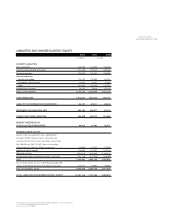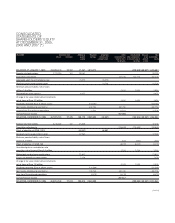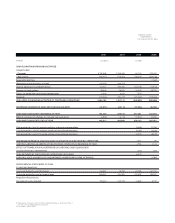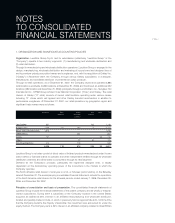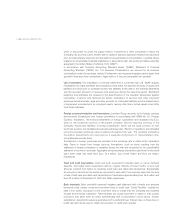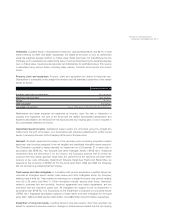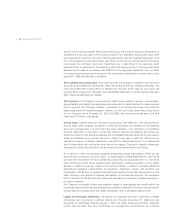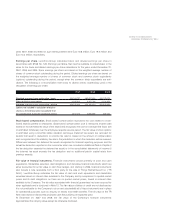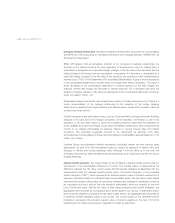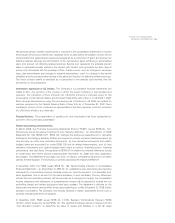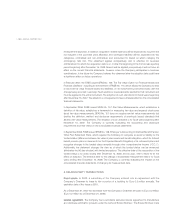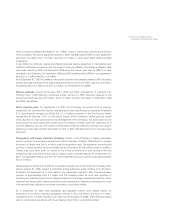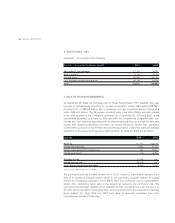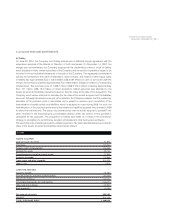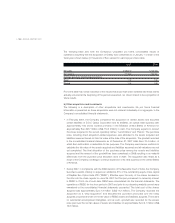LensCrafters 2007 Annual Report Download - page 129
Download and view the complete annual report
Please find page 129 of the 2007 LensCrafters annual report below. You can navigate through the pages in the report by either clicking on the pages listed below, or by using the keyword search tool below to find specific information within the annual report.> 128 | ANNUAL REPORT 2007
amount may not be recoverable. When such events occur, the Company measures impairment by
comparing the carrying value of the long-lived asset to the estimated undiscounted future cash
flows expected to result from the use of the long-lived assets and their eventual disposition. If the
sum of the expected undiscounted future cash flows is less than the carrying amount of the long-
lived assets, the Company records an impairment loss, if determined to be necessary. Such
impairment loss is measured as the amount by which the carrying amount of the long-lived asset
exceeds the fair value in accordance with SFAS 144. The aggregate impairment loss on certain
non-performing long-lived assets charged to the consolidated statements of income during fiscal
years 2007, 2006 and 2005 was not material.
Store opening and closing costs. Store opening costs are charged to operations as incurred in
accordance with Statement of Position No. 98-5, Accounting for the Cost of Start-up Activities. The
costs associated with closing stores or facilities are recorded at fair value as such costs are
incurred. Store closing costs charged to the consolidated statements of income during fiscal years
2007, 2006 and 2005 were not material.
Self insurance. The Company is self insured for certain losses relating to workers’ compensation,
general liability, auto liability, and employee medical benefits for claims filed and for claims incurred
but not reported. The Company’s liability is estimated on an undiscounted basis using historical
claims experience and industry averages; however, the final cost of the claims may not be known
for over five years. As of December 31, 2007 and 2006, self insurance accruals were Euro 40.9
million and 37.4 million, respectively.
Income taxes. Income taxes are recorded in accordance with SFAS No. 109, Accounting for
Income Taxes, which requires recognition of deferred tax assets and liabilities for the expected
future tax consequences of events that have been included in the Company's consolidated
financial statements or tax returns. Under this method, deferred tax liabilities and assets are
determined based on the difference between the consolidated financial statement and tax basis of
assets and liabilities using enacted tax rates in effect for the year in which the differences are
expected to reverse. A valuation allowance is recorded for deferred tax assets if it is determined
that it is more likely than not that the asset will not be realized. Changes in valuation allowances
from period to period are included in the tax provisions in the relevant period of change.
As of January 1, 2007, the Company adopted Financial Accounting Interpretation (“FIN”) No. 48,
Accounting for Uncertainty in Income Taxes - an interpretation of FASB Statement No. 109. FIN 48
provides that a tax benefit from an uncertain tax position may be recognized when it is more likely
than not that the position will be sustained upon examination, including resolutions of any related
appeals or litigation processes, based on the technical merits. In addition, it provides additional
requirements regarding measurement, de-recognition, disclosure, interest and penalties and
classification. FIN 48 must be applied to all existing tax positions for all open tax periods as of the
date of adoption (see Note 8 for a tabular reconciliation of uncertain tax positions). The cumulative
effect of adoption of FIN 48 of Euro 8.1 million was recorded as a reduction to retained earnings on
the date of adoption.
The Company recognizes interest and penalties related to unrecognized tax benefits within the
income tax expense line in the accompanying consolidated statements of income. Accrued interest
and penalties are included within the related tax liability in the consolidated balance sheet.
Liability for termination indemnities. The reserve for employee termination indemnities of Italian
companies was considered a defined benefit plan through December 31, 2006 and was
accounted for accordingly. Effective January 1, 2007, the Italian employee termination indemnity
system was reformed, and such indemnities are subsequently accounted for as a defined



